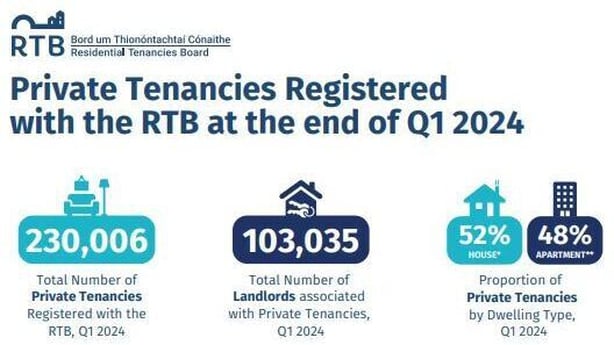The number of private registered landlords renting homes to tenants in Ireland rose by almost 7% to 103,035 between the middle of last year and March of this year.
New data also shows that the proportion of private tenancies associated with small landlords with just one tenancy remained roughly static across the same timeframe, at around 26%.
This is despite suggestions from the sector that small landlords are leaving the market in large numbers due to rising costs and policy challenges.
In contrast, nationally the proportion of private tenancies associated with large landlords owning 100 or more properties increased from 9.5% to 11.17% over the nine-month period.
This suggests that larger institutional landlords continue to see the Irish market as an attractive investment proposition.
The information is contained in a new public data hub launched by the Residential Tenancies Board (RTB), which for the first time allows users to access more accurate and in-depth quarterly information about the Irish rental sector.
It follows improvements made to the register between 2021 and 2023, including the requirement for landlords to register tenancies annually.
"The launch of this new data series marks the culmination of significant work to improve the RTB's registration processes and the accuracy of data on the Register since 2021," said Brian Gallwey, Research Officer with the RTB.
"The new data breakdowns published today will provide valuable insights on the changing face of Ireland’s rental sector for policy makers."

The hub shows that at the end of March, there were 230,006 private tenancies registered, up 16,829 or 7.9% from the end of the second quarter of 2023.
Indeed, the data shows there was a rise in the number of tenancies in each of the three quarters after June of last year, when the series began.
The information does not explain what drove the increase, however, with the shortage of houses to buy, population growth and more landlords complying with the registration requirements all possible reasons.
Nationally, 52% of tenancies were in apartments, with the balance in houses.
Between June of last year and March of this year, the number of apartment tenancies rose by 9,673, with house tenancies climbing by 7,333.
Two and three bedroom properties are the most common dwelling sizes, accounting for 155,196 of the tenancies registered in the first three months of this year.
Unsurprisingly, the highest number of private tenancies at the end of the first quarter this year was in Dublin, at 99,630, with the lowest number being in Monaghan at 1,827.
The data also reveals big differences in the types of landlords operating in Dublin compared to the rest of the country.
In Dublin, the proportion of private tenancies associated with landlords who own 100 or more properties was 22.6% at the end of March, up from 19.87% in June of last year.
However, outside the capital the proportion of private tenancies associated with such large landlords was just 2.6%.
Meanwhile, in Dublin the proportion of private tenancies associated with landlords who have one to three properties was 40.3% in March.
However, in the rest of the country that figure was 51.6%.
81% of the private tenancies registered at the end of March were in Rent Pressure Zones (RPZs), where landlords are restricted in how much they can increase rent by.
The data also includes tenancies related to Approved Housing Bodies (AHB) and shows there were 46,200 on the register at the end of March, up 5,073 from June of last year.
The highest number, at 15,529, was in Dublin, with the lowest recorded in Longford at 306.
Large landlords with 100 or more properties account for 91% of AHB tenancies, with medium landlords who have 3-99 properties making up 8.9% of AHB tenancies and small landlords with 1-2 homes making up just 0.04% of AHB tenancies.
21,701 AHB registered tenancies were in apartments, while 24,497 were in houses. Two and three bedroom properties are the most common dwelling sizes, accounting for 33,745 tenancies registered.
As well as breaking the data down by county, the new hub also allows user to explore by local authority and by local election area.
We need your consent to load this rte-player contentWe use rte-player to manage extra content that can set cookies on your device and collect data about your activity. Please review their details and accept them to load the content.Manage Preferences
'We need a mix [of types of landlords] in cities'
Minister for Public Expenditure Paschal Donohoe has defended the rise in the number of corporate landlords, after it emerged one in five rental properties in Dublin are now owned by corporate landlords.
Speaking to reporters at the launch of the mid-year economic review figures, Minister Donohoe was asked about the RTB report which said in March 22.6% of rental properties in Dublin were owned by landlords with 100 or more properties.
This percentage is up from 19.87% in June of last year.

Responding to suggestions this indicates a problem in the rental sector, Minister Donohoe said Government has "always said we need a mix [of types of landlords] in cities".
Minister Donohoe said that "far from seeing corporate landlords as a failure", in his view the "scale" of rental properties needed due to the housing crisis means the involvement of "corporate landlords is the only way this can be done".
Minister Donohoe said any party which believes there is no need for corporate landlords is in his view incorrect.
Asked with what percentage of corporate landlords in the sector he would be comfortable, Minister Donohoe said, "I'm less interested in" the exact percentage "than the level" of properties in actual numbers, and repeated there should be "a mix".
At the same press conference, Minister Donohoe was also asked about a 7% increase in the number of landlords to 103,000, and if this suggests Government support in the last budget to prevent landlords leaving the sector was necessary.
He said: "The fact we have seen some evidence small landlords still want to stay in rental sector for me it's a positive sign and a sign some of measures brought did have an effect."







